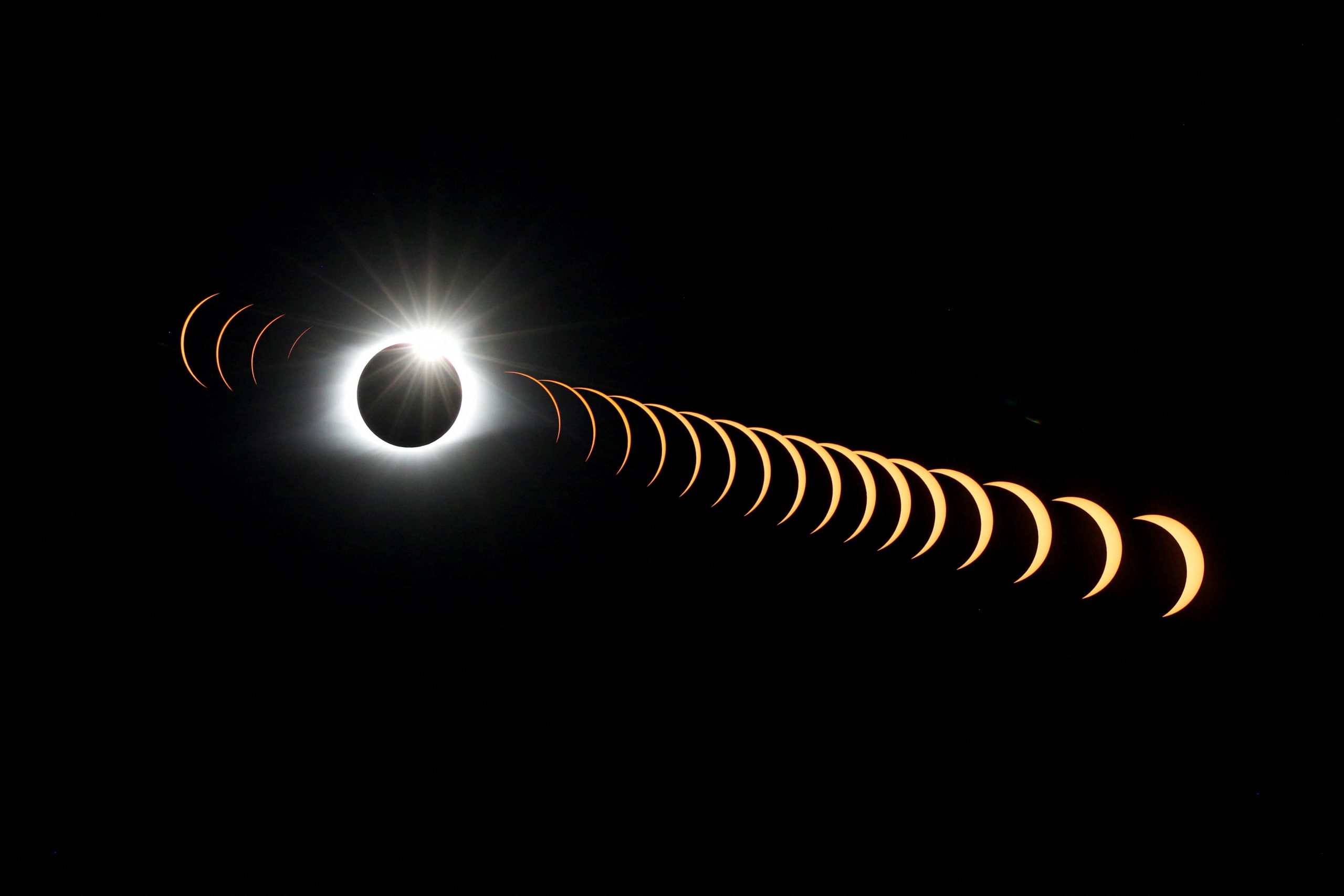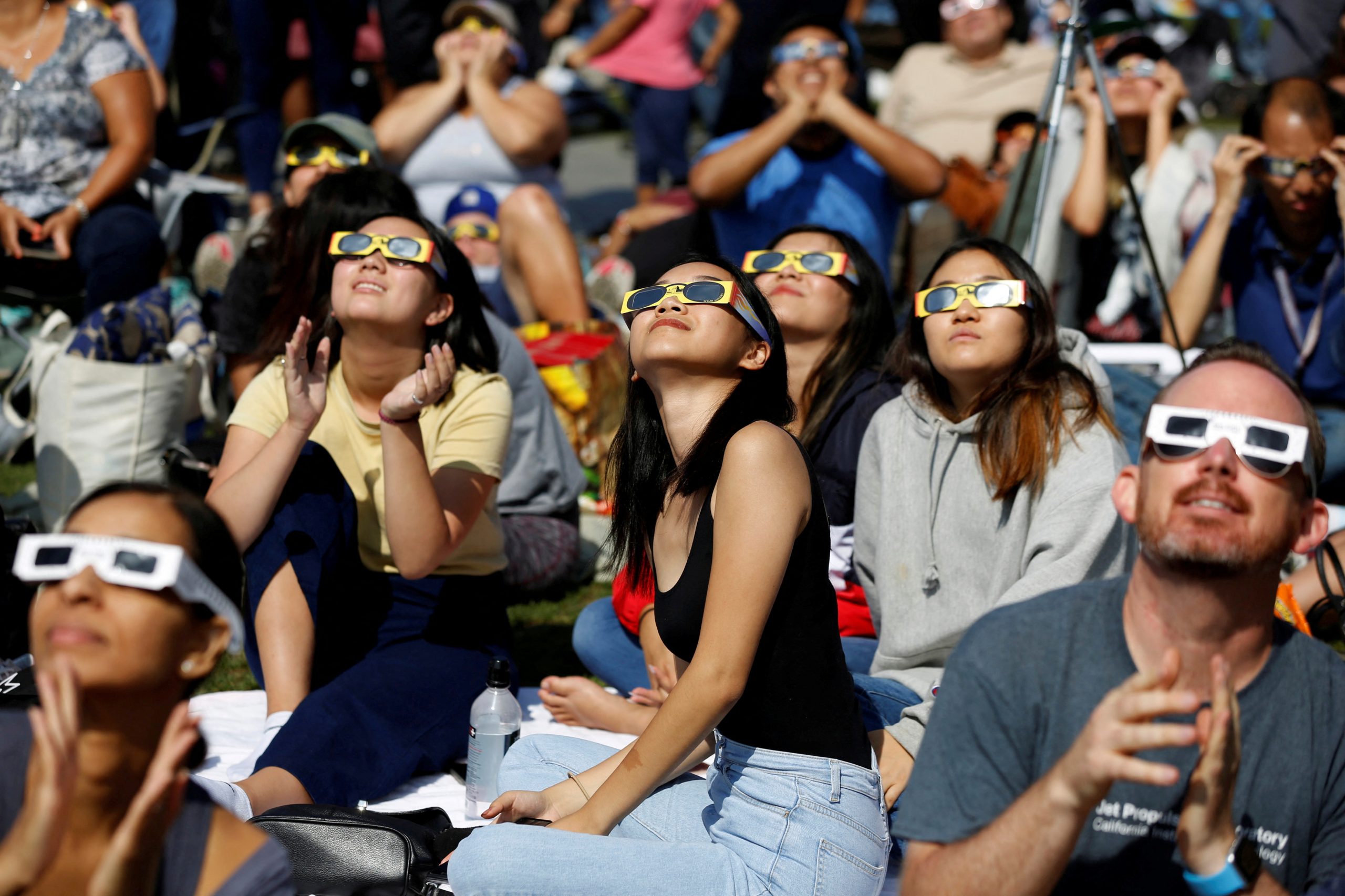Last Updated:
Washington D.C., United States of America (USA)

People watch the solar eclipse during the Lowell Observatory Solar Eclipse Experience at Madras High School in Madras, Oregon, U.S. August 21, 2017. (Reuters/File Photo)
Witness the celestial spectacle! North America prepares for a total solar eclipse. Stream online coverage, join watch parties. Don’t miss this rare event!
North America is set to brace another celestial spectacle as a total solar eclipse approaches on April 8. The eclipse’s path will begin along Mexico’s Pacific coast, traverse through Texas and 14 other US states, before culminating over Canada. The moon will shroud the sun for up to 4 minutes, and 28 seconds, a spectacle normally unfolding in remote corners of the globe.
An estimated 44 million people live within the path of totality, with another couple hundred million within 320 kilometers. Most people on the continent will get to see a partial eclipse. For those that don’t belong to that part of the world, NASA will be streaming online from several cities along the totality path. Click Here to Watch The Solar Eclipse.
What’s a total solar eclipse?
The moon will line up perfectly between the Earth and the sun at midday, blotting out the sunlight. The full eclipse will last longer than usual because the moon will be just 360,000 kilometers from Earth, one of the year’s closest approaches. The closer the moon is to Earth, the bigger it is in the sky from our perspective, resulting in an especially long and intense period of sun-blocked darkness.
What’s the eclipse path?
The moon’s shadow will slice a diagonal line from the southwest to the northeast across North America, briefly plunging communities along the track into darkness. Totality will enter the continent at Mazatlan, Mexico, and exit at Newfoundland in Canada. In between, 15 US states from Texas to Maine will experience totality, including snippets of Tennessee and Michigan. It will be a repeat for Cape Girardeau, Missouri, and Carbondale, Illinois, which were also in prime position for 2017’s total solar eclipse.
Here are some strange phenomena that may be witnessed during the solar eclipse:
- Bailey’s Beads: As the moon nears the sun, light seeps through lunar crevices, creating Bailey’s beads, named after Francis Bailey. According to Spacedotcom, he made the first recorded observations of Bailey’s beads during a solar eclipse on May 3, 1715. Watch for these before totality!
- Witness the Diamond Ring: Just before totality, catch the mesmerising “diamond ring” effect as the sun’s last rays gleam around the lunar edges. Look out for the rare double diamond ring!
- Unveiling the Sun’s Atmosphere: During totality, experience the surreal sight of the sun’s corona and chromosphere, typically obscured by sunlight. Marvel at solar filaments and waving white streamers.
- Celestial Guests: During totality, you may be able to spot a comet along with four planets, if you’re lucky. Spot Venus, Jupiter, Saturn, and Mars during totality. Beyond planets, expect Sirius, Capella, and Rigel to grace the sky, visible due to the eclipse’s darkness.
- Encounter the ‘Devil’ Comet: Keep an eye out for Comet 12P/Pons-Brooks, known for its “horned aura,” potentially visible between the sun and Jupiter if conditions align.
- Enigmatic Shadow Bands: Experience the eerie phenomenon of shadow bands, alternating light and dark bands visible during the lead-up to totality, caused by atmospheric turbulence.
- Chromatic Shifts: Observe the surreal colour shifts during the eclipse, as familiar hues warp due to fluctuating light levels, accentuated by the “Purkinje shift.”
- Einstein’s Gravitational Lensing: Witness the bending of light in line with Einstein’s theory of general relativity. Background stars appear to shift due to the sun’s mass warping space-time.
More on solar eclipse
The US hasn’t experienced a total solar eclipse since Aug. 21, 2017, although a “ring of fire” solar eclipse crossed a part of the country last October. The moon was too far away then to completely blot out the sun, leaving a brilliant, burning ring around our star.
The dramatic “ring of fire” stretched from Oregon to Texas, and crossed over Central America and Colombia, before exiting over Brazil. Kerrville, Texas, just west of San Antonio, is back in the bull’s-eye and expecting another packed house.
When’s the next one?
After Monday, the next total solar eclipse won’t occur until 2026. But it will graze the top of the world, dipping into Greenland, Iceland and Spain. The next one in 2027 will march across Spain and northern Africa, with totality lasting an incredible 6 1/2 minutes.
North Americans will have to wait until 2033 for another total solar eclipse, but it will be limited to Alaska. In 2044, Western Canada, Montana and North Dakota will have front-row seats. And in 2045, the U.S. will once again experience a coast-to-coast total solar eclipse.
(With agency inputs)


